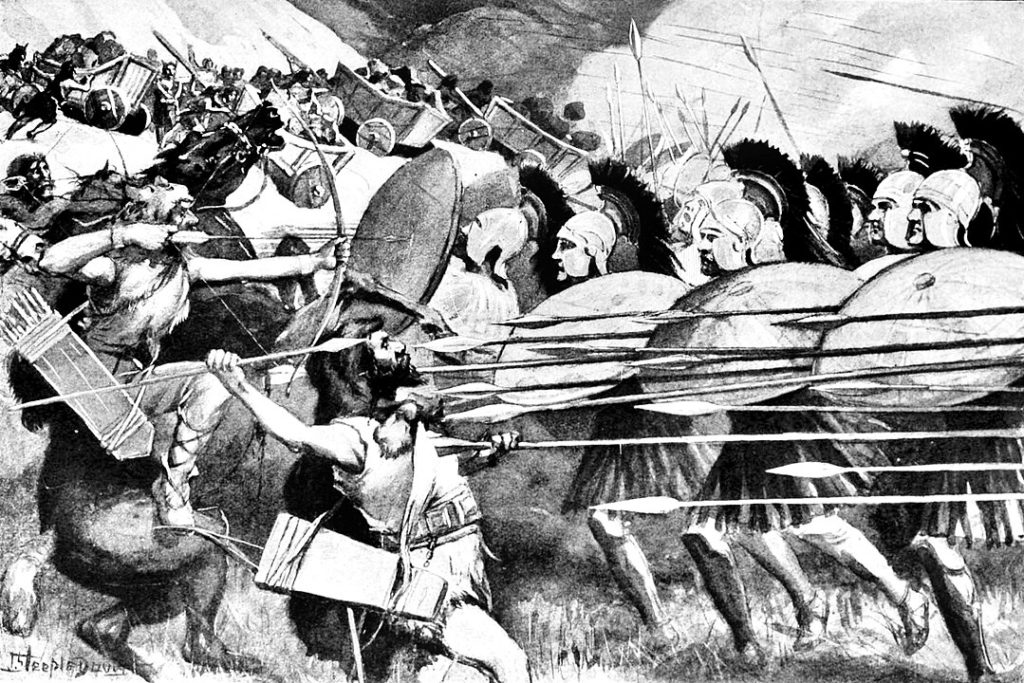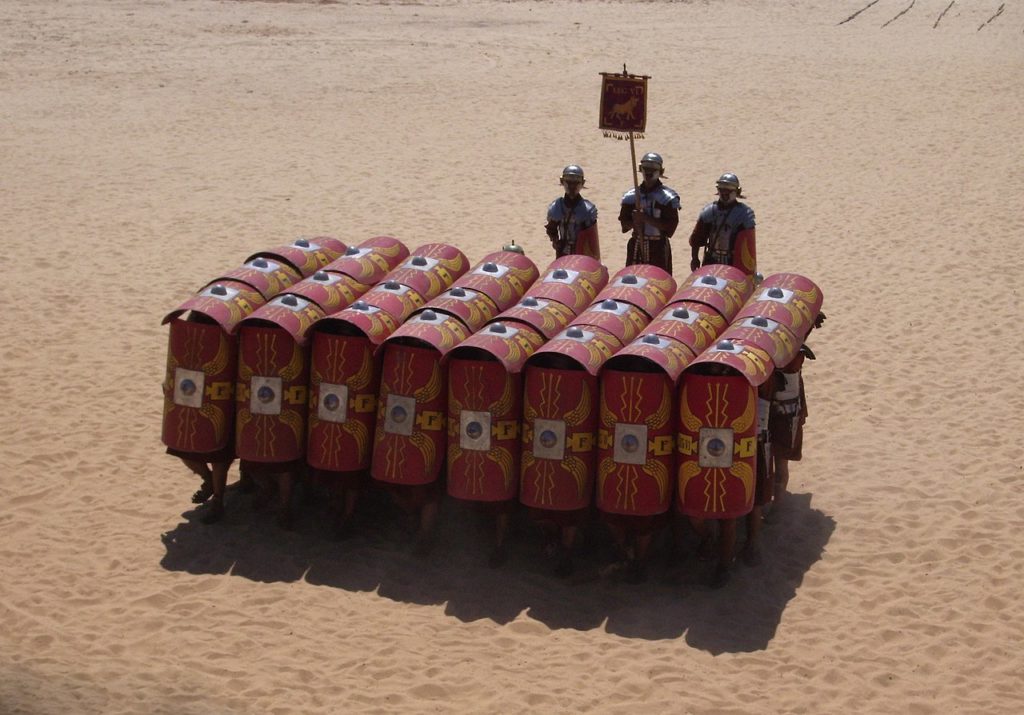
The ancient Greek and Roman armies were large and fearsome for their time, yet their warfare tactics and leadership during battle were quite different.
Military might was very important for ancient kingdoms to survive and even more important in building and maintaining a successful empire.
The ancient Greek armies’ warfare tactics were based on the phalanx formation. It relied on a block of heavily armed infantry standing shoulder to shoulder in files several ranks deep, using their shields for protection and pushing and long spears for killing.
Roman warfare tactics were more complex and organized than those of the Greek armies, especially as pertains to the Spartans, who liked to fight for individual glory. The Roman military was about coordinated attacks and glory for the fighting unit as a whole.
There were differences in leadership between the two armies, as well. The Greeks, mostly the Athenians, believed in openness and honesty in their leadership. For instance, during the Peloponnesian War, there were philosophical discussions about whether it was adequate for a leader to lie for an advantage over the enemy.
The Romans valued honesty in individuals but not necessarily in their government and those in power. They expected the government to work in their favor but understood that a certain type of openness could be disadvantageous at times.
The ancient Greeks, especially the Athenians, used the formation of massed infantry standing very close together, all joined as one giant fighting unit called the phalanx. The Romans, on the other hand, pioneered small-unit tactics and organized their troops into smaller formations capable of acting independently of the rest of the army.
The Greek Hoplite Phalanx
Greek hoplite infantrymen wore bronze armor breastplates, helmets, shin guards, shoulder pads, shin guards, thigh guards, and forearm guards. They held an eight-foot long spear, a short sword, and a bronze-covered wooden shield, with the total weight of their arms and armor weighing around sixty to seventy pounds, almost half their own bodyweight.
The hoplite infantrymen fought primarily in a phalanx, a tightly packed shield and spear formation that might be several ranks deep and many soldiers wide. It was a tight “war machine” that was successful in battle.
Furthermore, each of them interlocked their large shield with the man at their side. As the soldier held his shield with his left arm at the right side of the shield, the right half of his shield covered himself, leaving the left side to cover the man standing to his left.
When each soldier overlapped the right side of their shield with the left side of the man standing to their right, this created a scale-like shield wall reinforced by the overlapping of shields.
Fighting this way created a more brotherly bond in combat, as hoplites were reliant on each other to maintain a strong formation.
The common spear grip for fighting in a phalanx formation was to hold the spear overhand, with its tip pointing directly towards that of the enemy. Underarm grips were used, especially when facing against an opponent quickly charging towards them.
The phalanx was used primarily against other Greeks who obeyed the same honor-bound rules of warfare. Initially, it was very successful against foreign armies. The Greeks defeated the Persians using the phalanx, though the latter soon adopted their own tactics to overcome the close combat favored by Greek armies.
During the fifth century BC at the height of the Greek-Persian Wars, Greeks used shorter swords and less armor in order to ensure greater agility for closer combat. This was partly in response to the threat of Persian archers, who had forced the Greeks to run at them in full armor during the battles of Marathon in 490 BC and Plataea in 479 BC.
Roman Army Warfare Tactics
Compared to the Greek phalanx, the Roman army relied on various warfare formations for greater versatility in fighting against various foes or changing tactics during battle. The maniple formation was comprised of small legionnaire groups fighting simultaneously in different formations.
The square formation was used when Roman soldiers faced cavalry attacks. The soldiers would maneuver into such a formation, establishing a wall and an overhead cover with their shields while holding their spears upright. This way, horsemen would face a wall of spears. At the same time, Roman soldiers in the middle could throw spears at the soldiers who were attacking.
The circle formation was utilized when the Romans were surrounded. They formed a circle so that their backs would be covered no matter where the attacking enemies were coming from. The foes would be met with a sword pointing at their faces, legs, or groins. In the center of the circle, the Romans would have the bows and arrows so the archers could hit the enemy.
The tortoise formation, the most famous of all, was utilized when the legionnaires on the front, back, and sides held their shields to protect each flank. Meanwhile, legionnaires in the other lines held their shields aloft above their heads like a metal tortoise. This formation was ideal for sieges, allowing the Romans to get close to a fort gate and batter it with a ram. At the same time, the shields would protect them from arrows, boulders, or whatever was thrown at them.
The wedge formation, which looks like a distorted triangle, was ideal for attacking, having the most seasoned soldiers at the tip of the triangle to pierce the enemy ranks. The legionnaires would keep on running, cutting, and slashing at the enemy standing in their way until they were deep into their ranks. The speed and ferocity of the attack would have the enemy panicking.
The Pyrrhic War
The Pyrrhic War (280-275 BC) was the test for the ancient Greek warfare tactics against the Roman legions. Pyrrhus, King of Epirus (318–272 BC), was an ancient Greek general and statesman with family ties to Alexander the Great. He was widely regarded by his contemporaries and modern historians as one of the greatest military minds of antiquity.
A dispute between Rome and the former Greek colony of Tarentum resulted in the latter asking for help from Pyrrhus in fighting the Romans. Eager to expand west, Pyrrhus accepted. Besides being a great commander, he had a sizeable army and the advantage of twenty war elephants, something his opponent had not foreseen.

The Greek phalanx was comprised of about twenty thousand men with a force of roughly six thousand Tarentine hoplites who also contributed to the infantry battle line. This was along a strong cavalry contingent of about three thousand horsemen. The skirmishing force was made up of approximately two thousand archers and five hundred elite slingers from Rhodes.
The Roman legion numbered approximately forty-five thousand men. The Battle of Heraclea in 280 BC marked the war between the phalanx and the legion. Pyrrhus’ elephants proved crucial in the battle, as they scared the Romans’ horses that scattered.
Yet, both sides suffered substantial casualties. According to Plutarch, nearly fifteen thousand Romans were killed while thirteen thousand of Pyrrhus’ men were lost. For Pyrrhus, it was worse, as he lost almost half of his army and his most trusted generals.
Another battle followed in 279 BC at Asculum. Pyrrhus’ army dwindled even further. The final battle between the Greeks and Romans involving the testing of each other’s tactics was fought in Beneventum in 275 BC.
Once again, it was a battle in which both sides suffered great casualties, but the Romans ultimately came out on top because they managed to handle the elephants and had a greater number of troops than did the Greeks.
See all the latest news from Greece and the world at Greekreporter.com. Contact our newsroom to report an update or send your story, photos and videos. Follow GR on Google News and subscribe here to our daily email!



